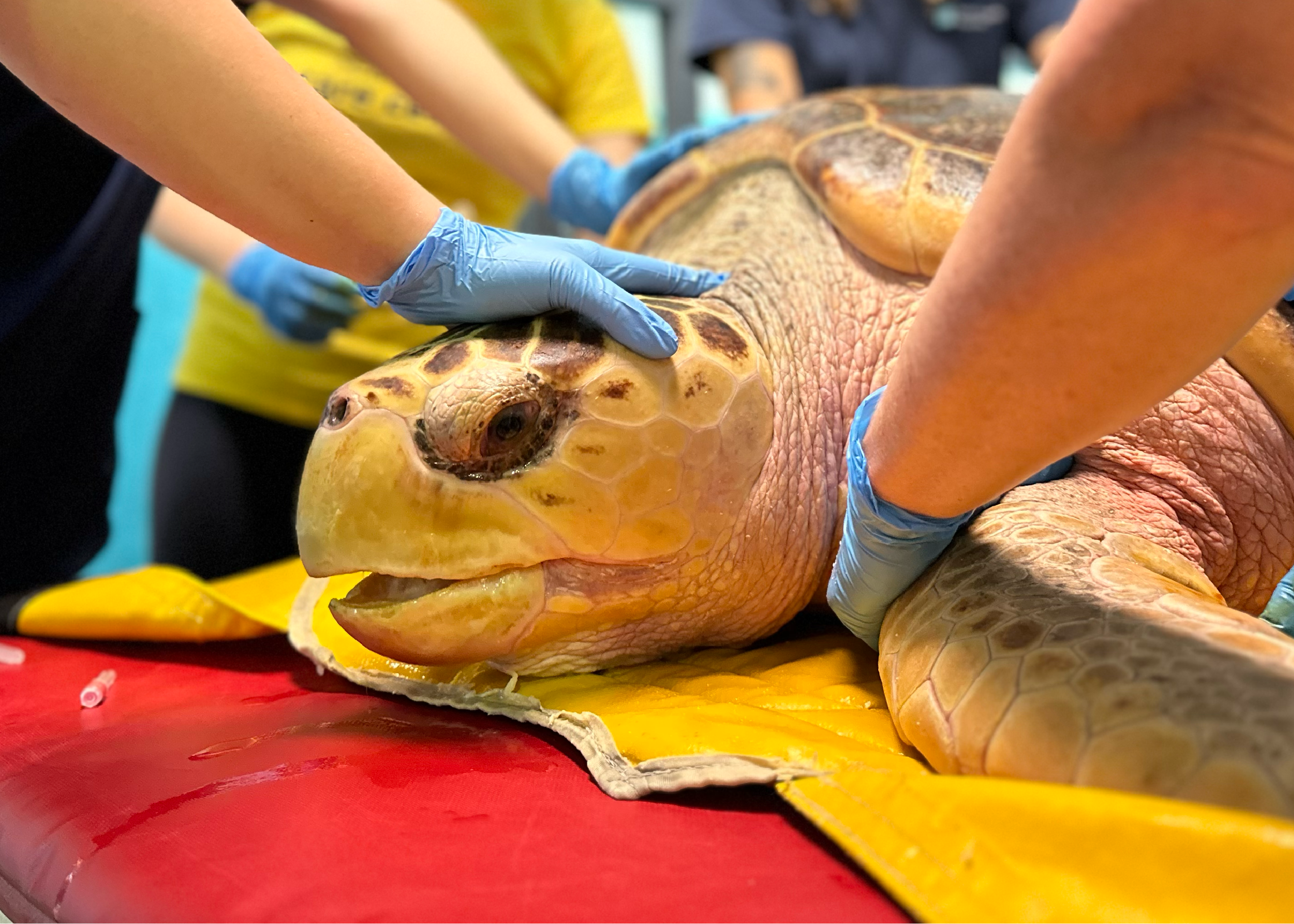25 years ago, a dying sea turtle was rushed to the Aquarium in a last-ditch effort to save her/him. Back then, there was no formal space in South Carolina to send a sick or injured sea turtle for rehabilitation, but we answered the call. Over the years, we’ve admitted hundreds more sea turtle patients, working our way from a makeshift temporary triage tank to an expanded, state-of-the-art rehabilitation hospital, offering every guest the opportunity to connect with these animals.
As we’ve grown our capacity to care for this special species, so have our experiences and skills. Let’s take a look back at some of our most memorable sea turtle patients.
Stinky Started It All (2000)
Lovingly named “Stinky,” this loggerhead sea turtle was our first patient admitted to the Aquarium! Stinky suffered from debilitated turtle syndrome, meaning s/he was emaciated, lethargic, dehydrated and had very poor bloodwork. Stinky was successfully released and paved the way for the hundreds of sea turtles that we have cared for since.
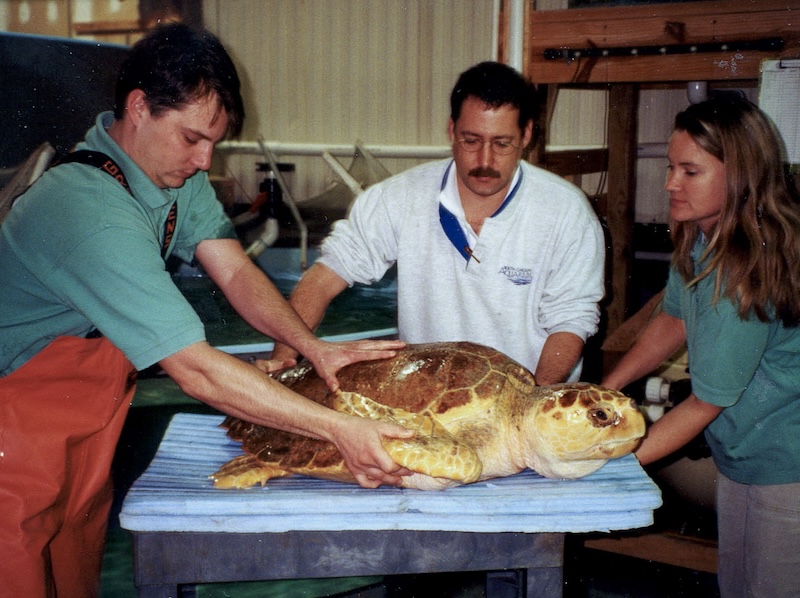 Stinky, a loggerhead sea turtle, was our first patient.
Stinky, a loggerhead sea turtle, was our first patient.Edisto Mama Draws a Crowd (2003)
As our sea turtle rehabilitation efforts expanded, so did the community’s interest and support. When adult loggerhead sea turtle Edisto Mama was ready to complete her journey home, we celebrated alongside our supporters by hosting the first public sea turtle release on Edisto Beach. This first milestone in our sea turtle rehabilitation journey set us up for many more exciting, tearful and joyous future release experiences.
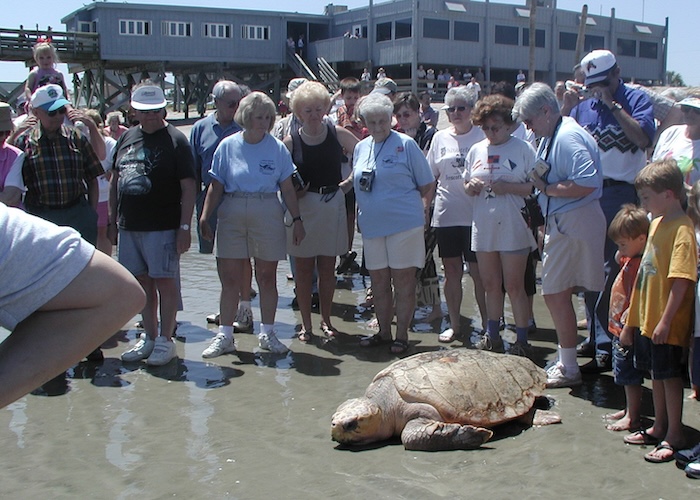 Edisto Mama was cheered on by a joyful crowd as she made her way to the water.
Edisto Mama was cheered on by a joyful crowd as she made her way to the water. Mama Pritchard Makes a Generational Impact (2008)
Mama Pritchard was our largest loggerhead sea turtle patient (360 pounds!) to undergo rehabilitation and release. Her size tested the strength of our life support systems, our food prep fridge and our biceps as we cared for her for nearly two years! In addition, this gorgeous loggerhead mama has been identified successfully nesting numerous times since her release, (and even before!), exemplifying the long-term population impact that saving just one sea turtle can have.
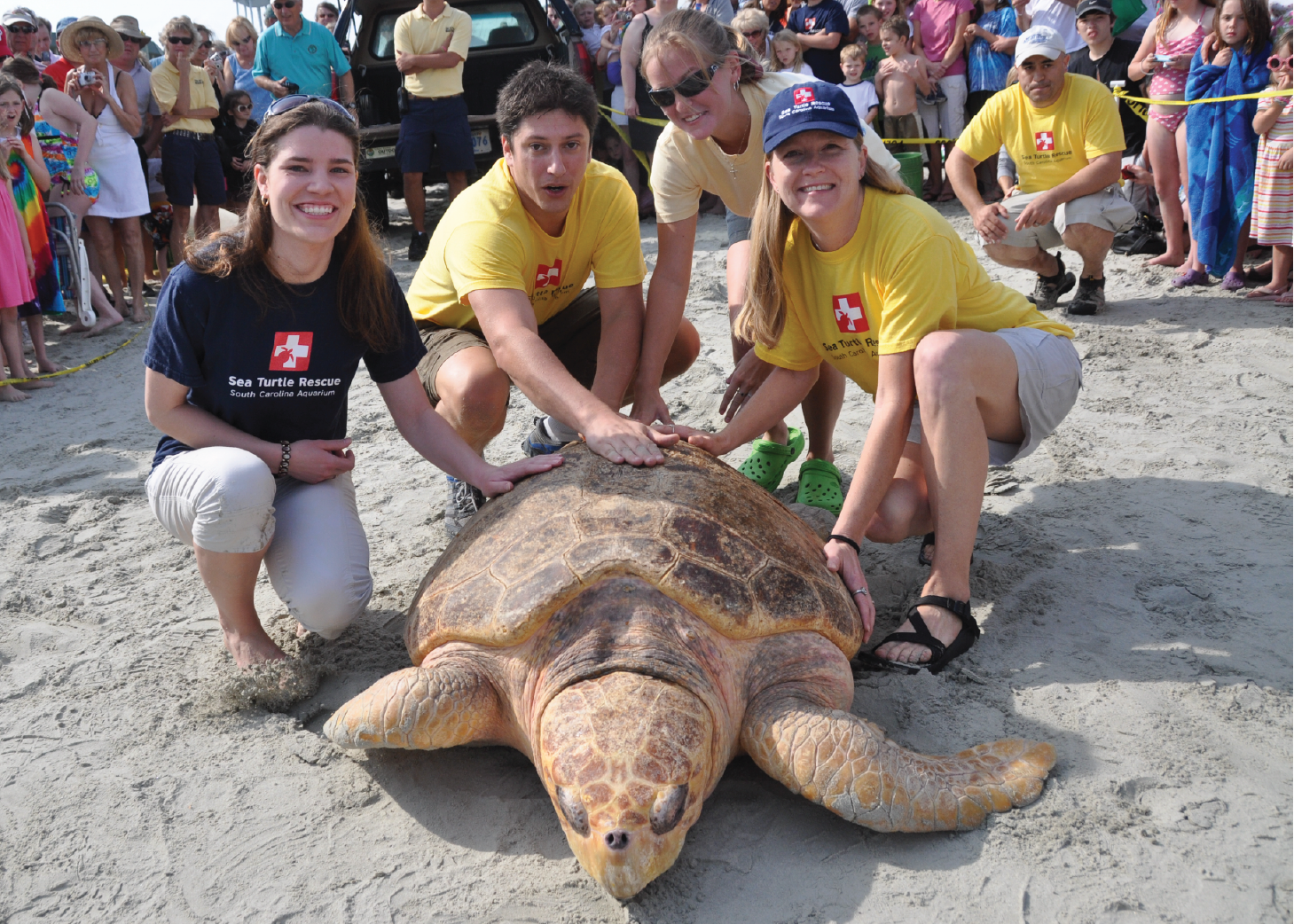 Mama Pritchard has nested in 2002, 2004, 2008, 2013, 2015, 2017, 2019, 2021 and 2023!
Mama Pritchard has nested in 2002, 2004, 2008, 2013, 2015, 2017, 2019, 2021 and 2023!Gumby Becomes Our 100th Release (2012)
Gumby was a very young loggerhead sea turtle admitted for a variety of problems, including lack of calcified bones in her/his body (inspiring the name). We theorized that Gumby was likely illegally taken from the beach as a hatchling by humans who didn’t know the needs of a sea turtle before being returned to the ocean sometime later. After 1.5 years of a strict diet, exercise and vitamin regimen, Gumby was successfully released far offshore near the Gulf Stream.
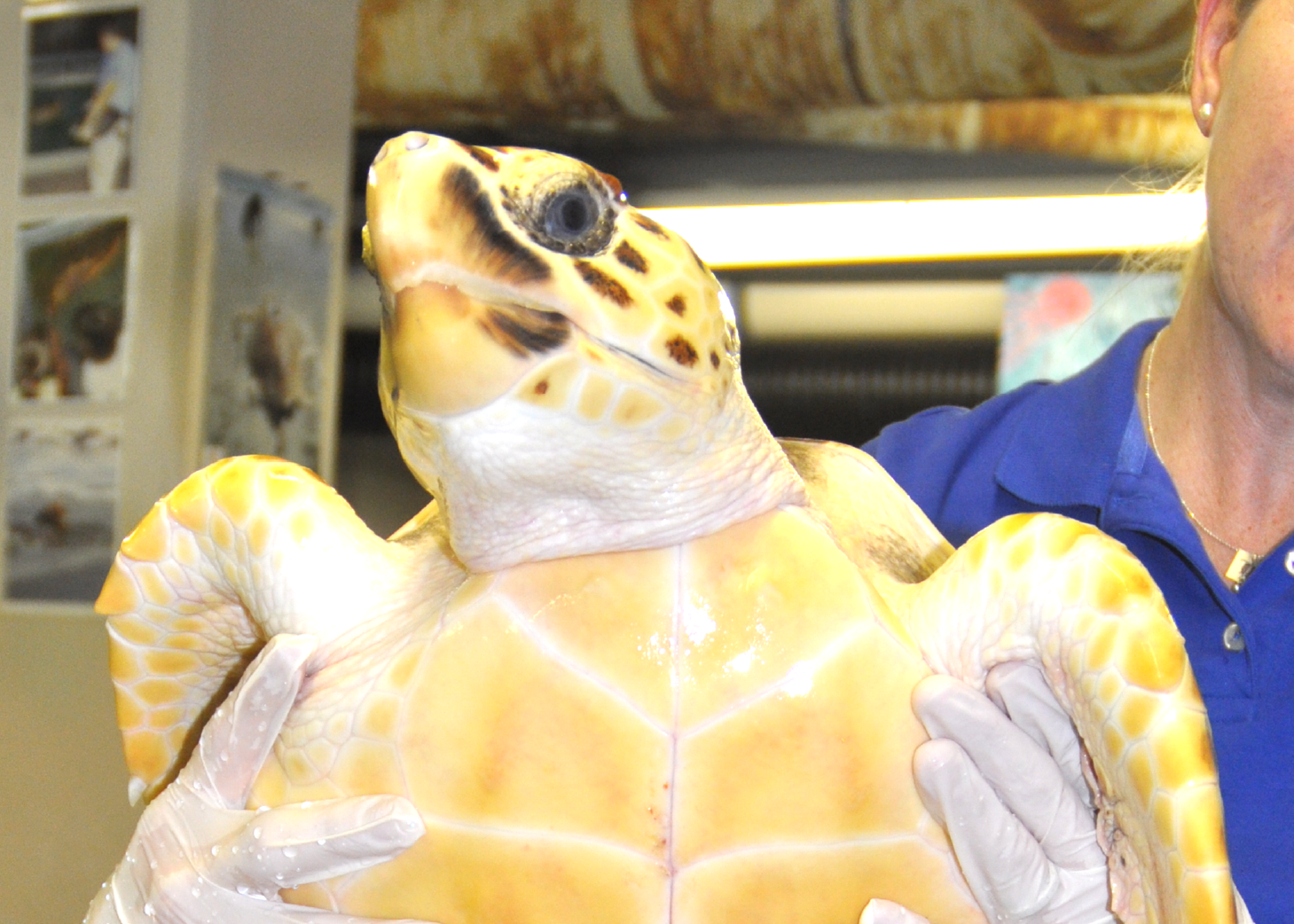 Gumby's release celebrated the hard work and dedication of our sea turtle biologists.
Gumby's release celebrated the hard work and dedication of our sea turtle biologists.Briar Brings Us Answers (2013, 2016)
Briar was a debilitated loggerhead that had developed cataracts in both of her/his eyes. To correct Briar’s vision and depth perception, we worked with a local veterinary ophthalmologist to perform our first cataract surgery! Though it took some adjusting, Briar recovered well and was released. Nearly two years later, Briar became our first repeat patient. Though s/he arrived with a boat strike wound, Briar was overall in decent health, confirming that cataract surgery can have long-term success for sea turtles. Since Briar, we’ve performed cataract surgeries on several other patients!
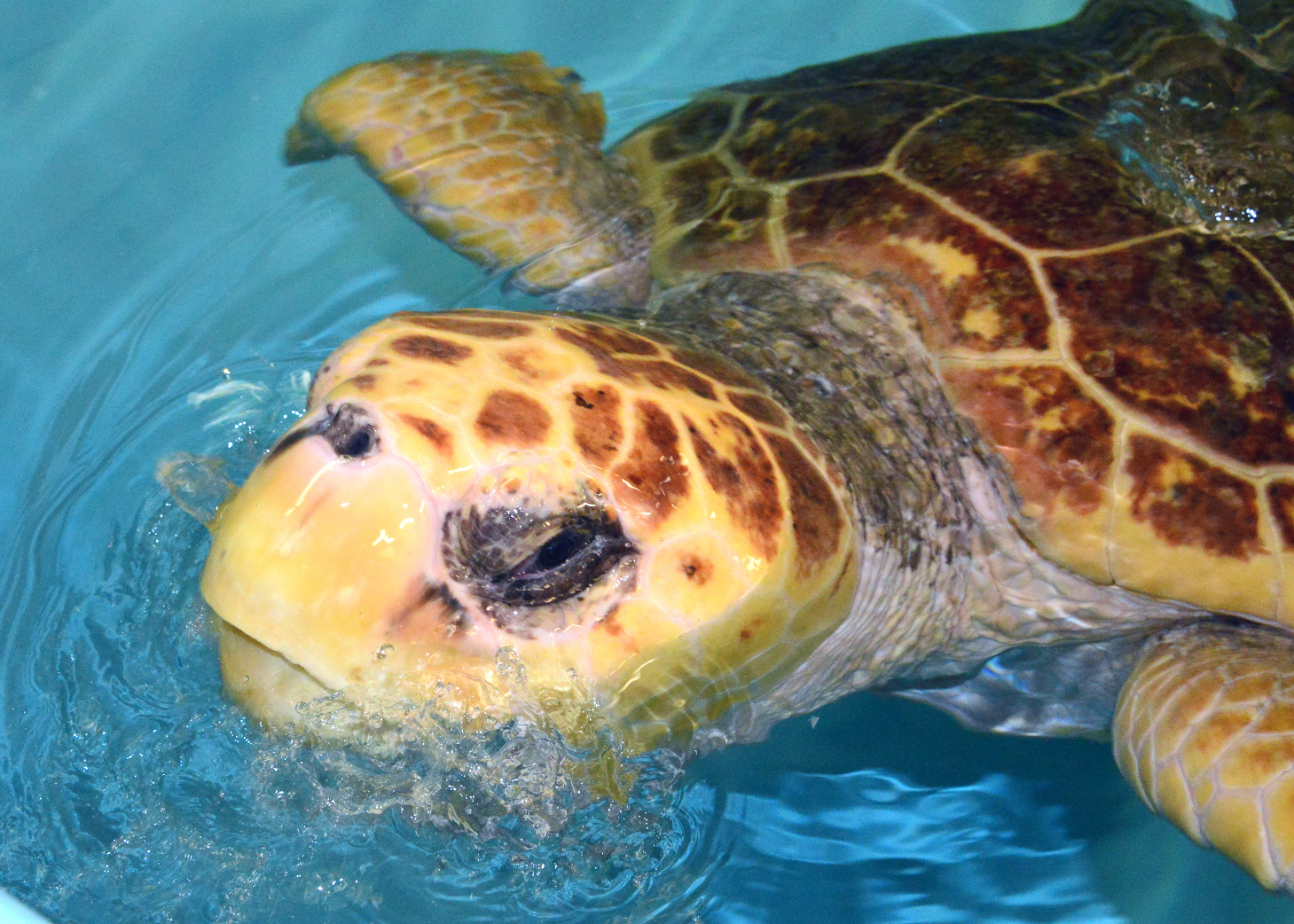 Briar's successful surgery paved the way for many more patients with cataracts.
Briar's successful surgery paved the way for many more patients with cataracts.Yawkey Becomes the Blueprint (2015)
It’s fairly common to spot a leatherback drifting along the coast in the spring; finding one stranded, however, is quite rare! Yawkey was the first leatherback ever admitted to the Aquarium, yet at a whopping 500 pounds, this sea turtle was still a juvenile! Though Yawkey was only in our care for a few days, this leatherback helped create a blueprint for how best to approach future rehabilitative support for this species.
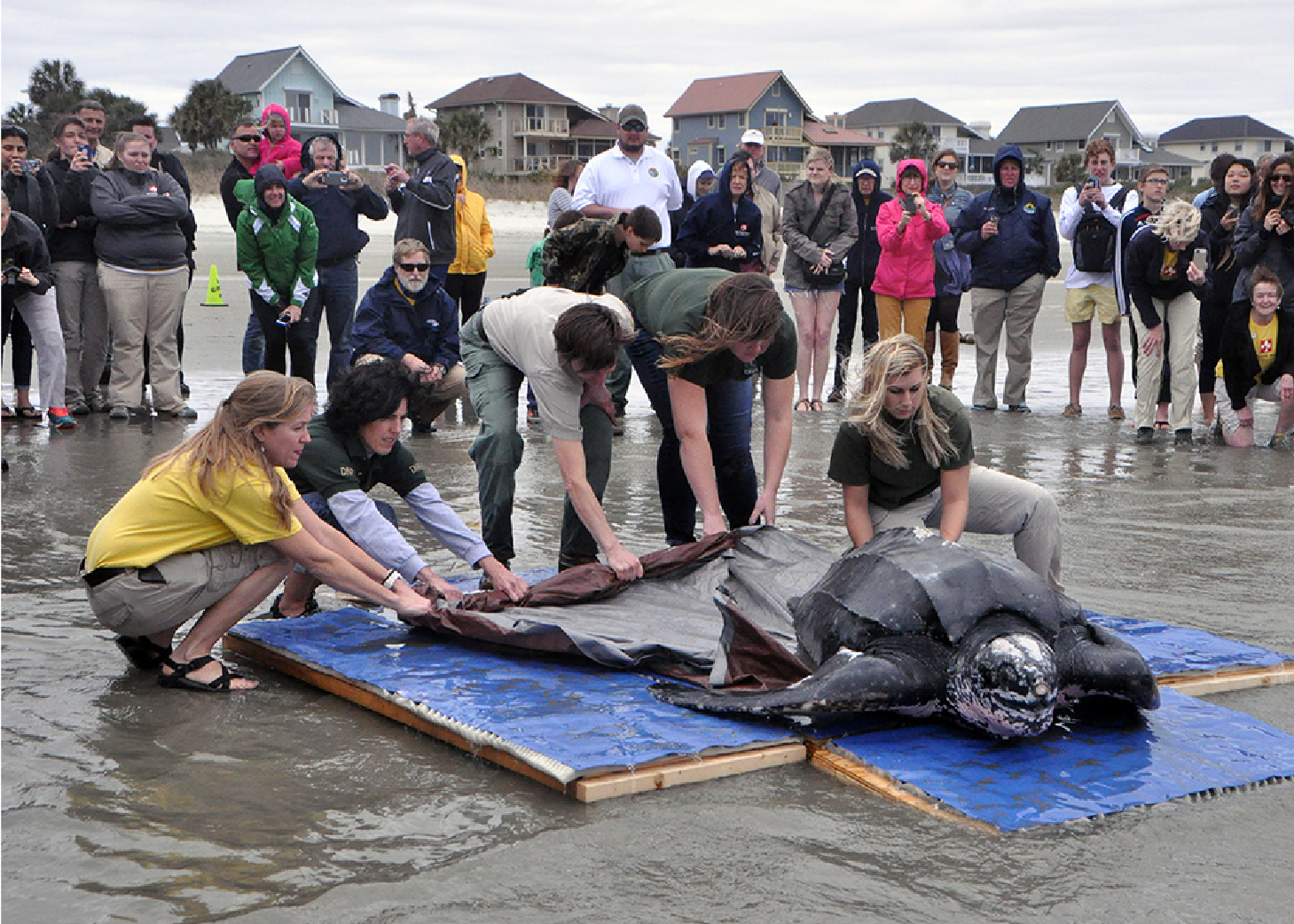 We built a custom transport container to release Yawkey so s/he could crawl right out into the waves.
We built a custom transport container to release Yawkey so s/he could crawl right out into the waves. Marsh Makes it as the 200th Release (2016)
Marsh was a perfect example of the most common species we’d admitted up until this point: the loggerhead sea turtle! It was kismet that s/he was our 200th released sea turtle who returned home to a cheering crowd of supporters on Isle of Palms!
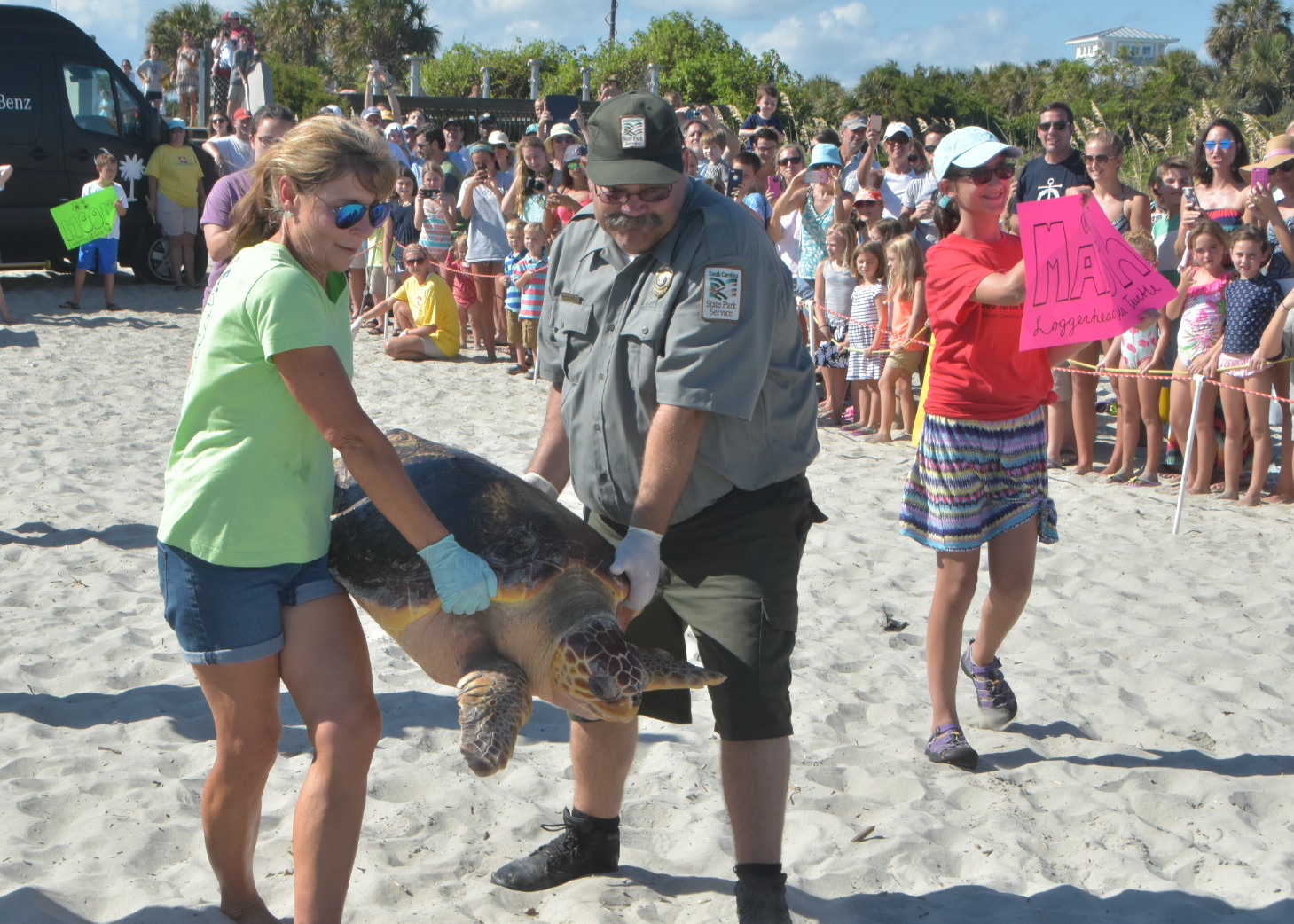 Marsh was cheered on by a crowd of several hundred onlookers!
Marsh was cheered on by a crowd of several hundred onlookers!Glenn Gets a Second Chance (2016)
Glenn was among several patients who were severely wounded by a hopper dredge in the Charleston Harbor. Glenn’s most pressing injury was a lung bulla, or an air-filled space in the lung caused by destruction of lung tissue. Using a unique method of treatment adapted by our own veterinarian, we injected Glenn’s own blood into the lung bulla, allowing it to fill the space, clot and heal on its own. This was the first time this technique had been performed on a sea turtle, and it was a success! Healthy and thriving five months later, Glenn was released.
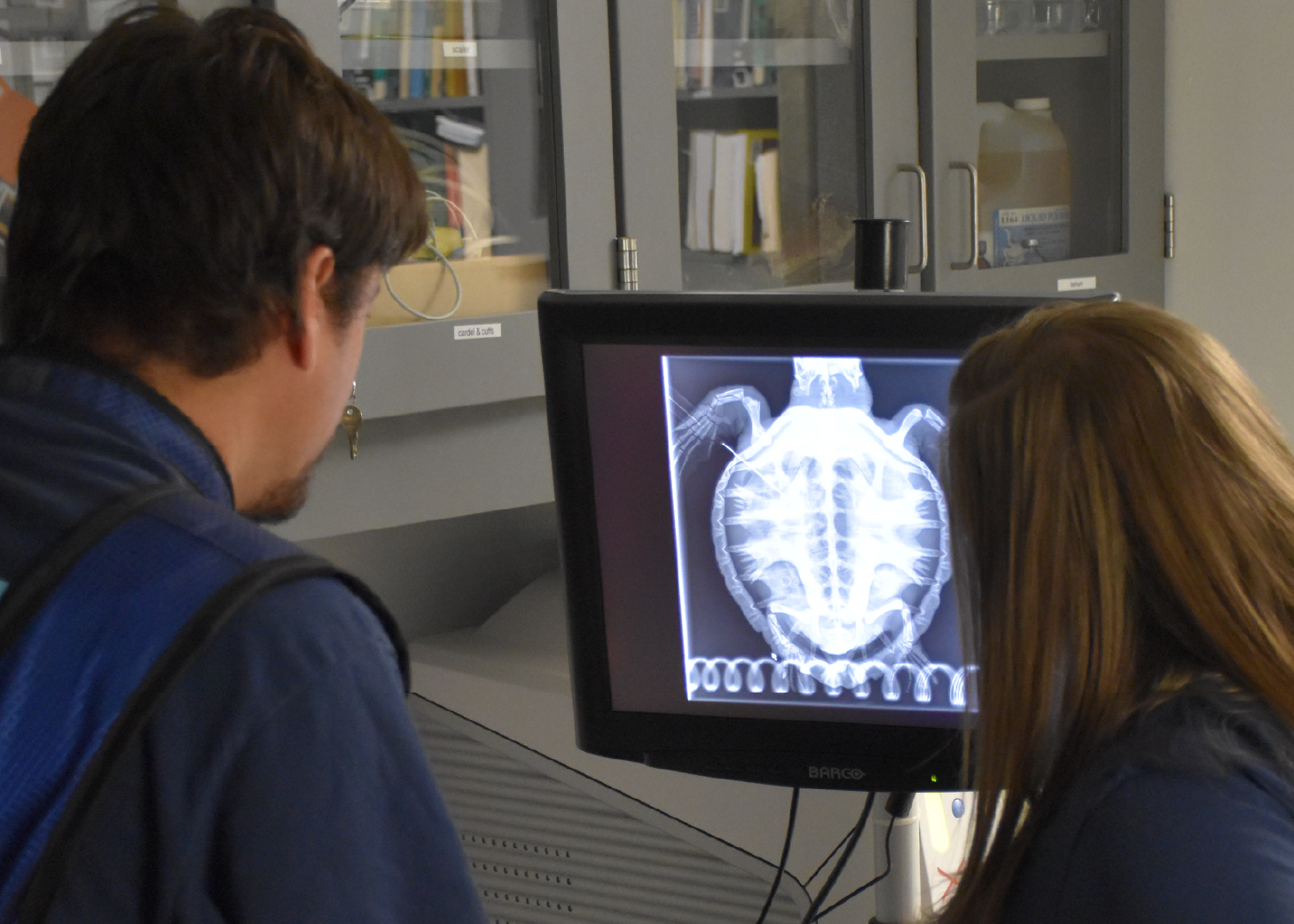 We used radiographs to carefully place the needle that would deliver Glenn's blood into the lung bulla.
We used radiographs to carefully place the needle that would deliver Glenn's blood into the lung bulla. Jacques Greets Our Guests (2017)
After years of saving sea turtles behind the scenes, we expanded hospital operations onto the first floor of the Aquarium for all guests to witness sea turtle rehabilitation in action! Jacques, a loggerhead who had suffered from debilitated turtle syndrome and ingested marine debris, was the first sea turtle patient to move in and greet our guests in this new and innovative experience.
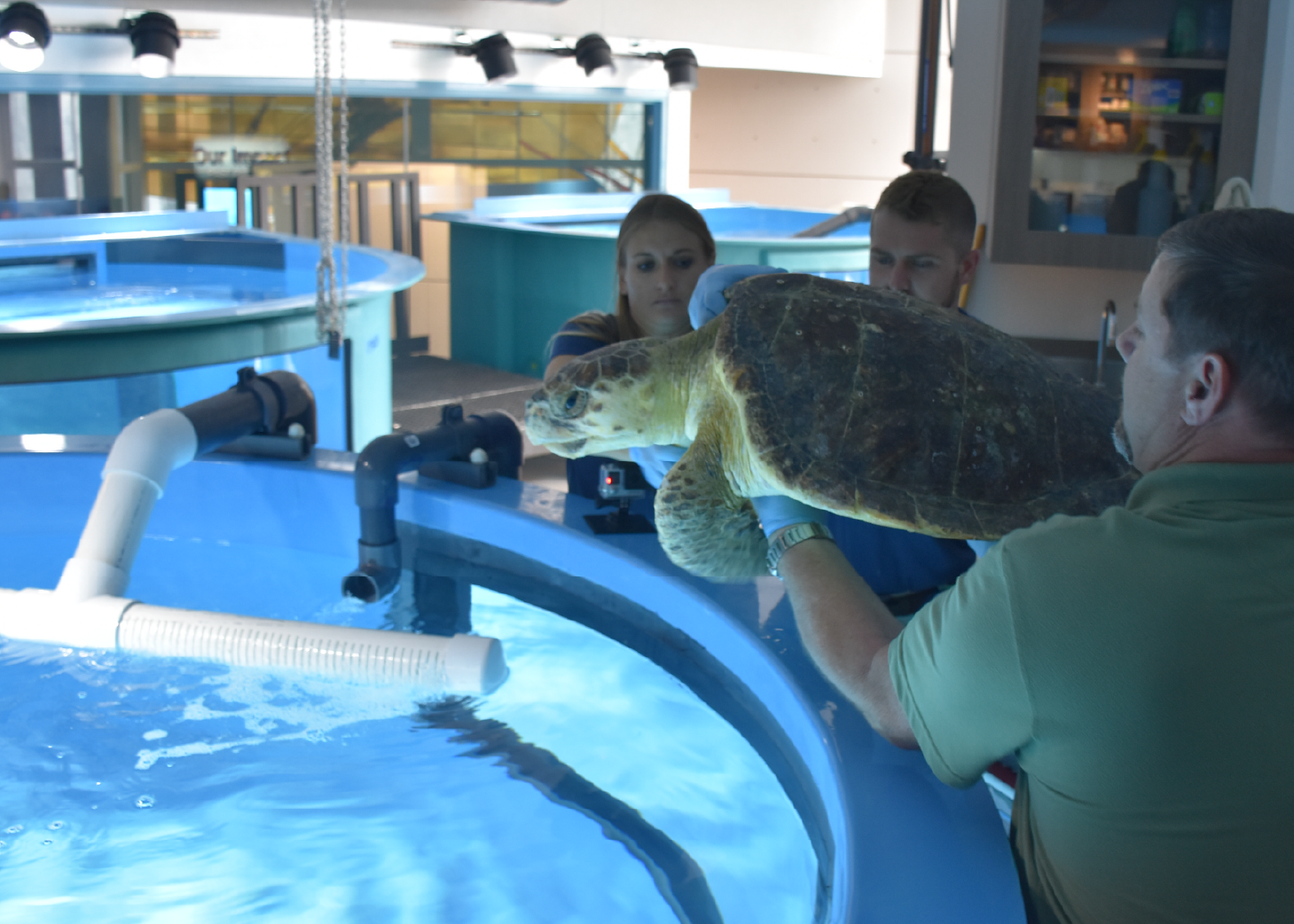 Jacques was ceremoniously placed into her/his new tank.
Jacques was ceremoniously placed into her/his new tank.Peach Survives Surgery (2017)
Peach holds numerous records as one of the few adult Kemp’s ridleys we’ve admitted and the first patient to undergo a public surgery. Peach was admitted with severe marine debris ingestion and entanglement. Using our new CT scanner, we discovered that the monofilament fishing line extended far into her gastrointestinal tract, requiring surgical removal to save her life. Peach’s story — and subsequent surgery to remove nearly 4 feet of fishing line — educated guests who witnessed it in real-time, brought nationwide attention to our work and raised awareness of the inextricable link between plastic pollution and sea turtle conservation.
 Guests watched Peach's surgery from start to finish through the surgical suite window.
Guests watched Peach's surgery from start to finish through the surgical suite window.Timon Tests Fish Skin Grafts (2019)
Tiny Timon arrived with chronic debilitated turtle syndrome that came with a whole slew of complications, including an open wound on the flipper with an underlying bone infection. Traditional treatment options weren’t working, so we had to get creative with our care. Enter: fish skin! For the first time in our history, we used medical-grade fish skin to cover the wound in the hopes of promoting naturally occurring skin regeneration. Seeing improvements after this method was quite the milestone, and we have since used fish skin grafts for other patients needing this novel option.
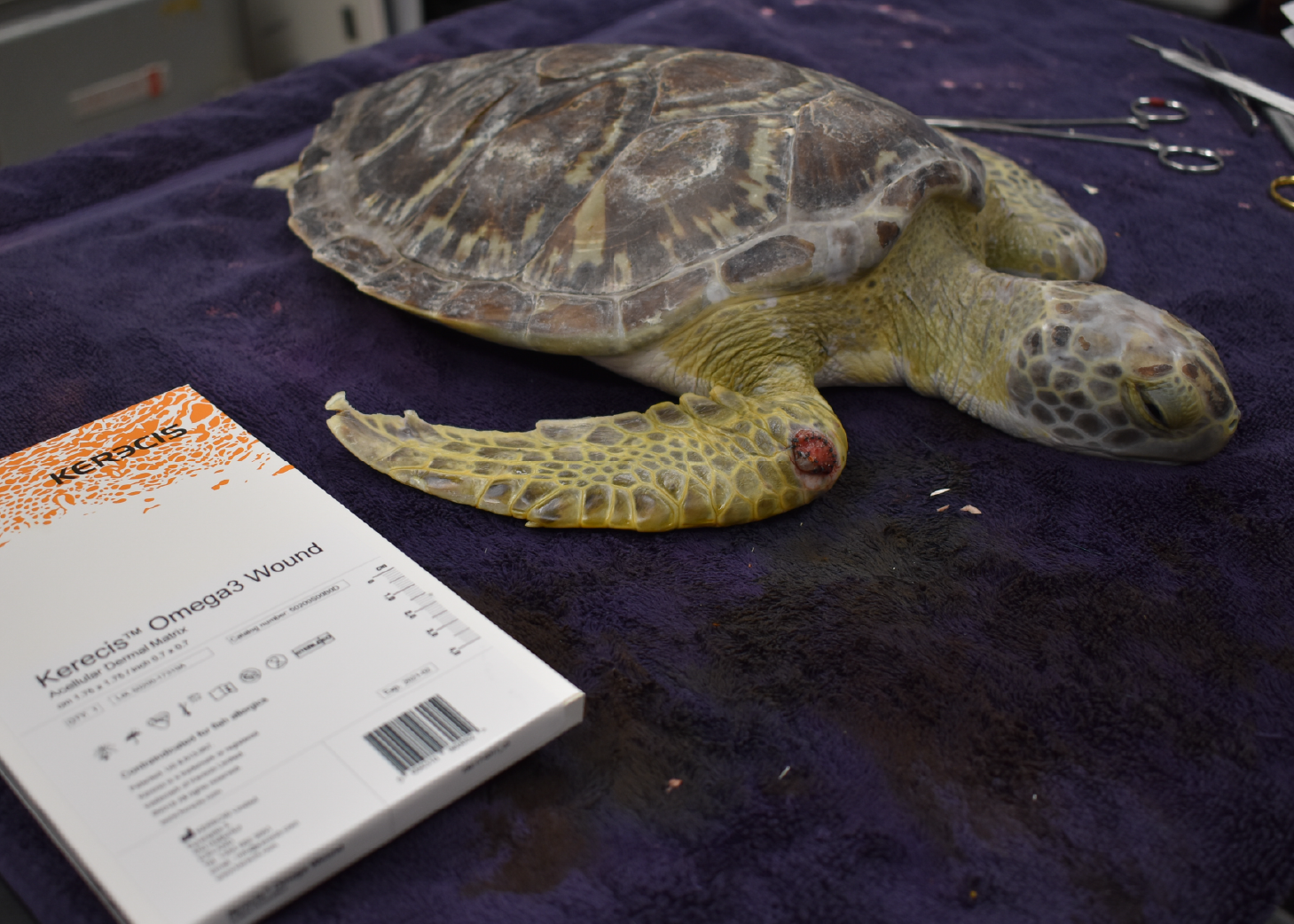 The fish skin patch sped up healing for Timon's elbow wound.
The fish skin patch sped up healing for Timon's elbow wound. Valentine Receives Stem Cell Treatment(2020)
Valentine was another patient who was pulled up from the bottom of the Charleston Harbor in a hopper dredge, causing severe carapace fractures and decompression sickness. Right away, we placed Valentine on oxygen and raced her/him to a local clinic with a decompression chamber to treat this dangerous illness. After Valentine was stabilized, we addressed her/his carapace fractures, which were severe enough to paralyze the rear flippers. So, we turned to another innovative treatment option: stem cells! We injected sea turtle stems cells directly into Valentine’s spinal cord to promote healing and bring back use of those flippers. It was a success and Valentine slowly but surely regained use of the rear limbs well enough to be released!
 Stem cells promoted the regeneration of Valentine's spinal cord!
Stem cells promoted the regeneration of Valentine's spinal cord!Hungry Neck Heals an (Almost) Amputation (2020)
Hungry Neck was hit by a boat and subsequently suffered predation wounds, including a missing rear flipper and the other with a gash so deep it was a miracle it was still attached. Guided by the success of Timon’s fish skin patch, we used this same approach to try and save Hungry Neck’s almost amputated flipper by creating a latticework of sorts for the skin and muscle cells to adhere to. Thanks to a remarkable recovery, Hungry Neck went on to be released seven months later.
 Hungry Neck regained full use of the injured rear flipper prior to release!
Hungry Neck regained full use of the injured rear flipper prior to release!Jasper Thrives as the 300th Release (2020)
The Kemp’s ridley sea turtle is the smallest and most endangered sea turtle species in the world. So, when Jasper was ready to return home as our 300th released turtle, we were not only celebrating a major milestone for ourselves, but for the species as well.
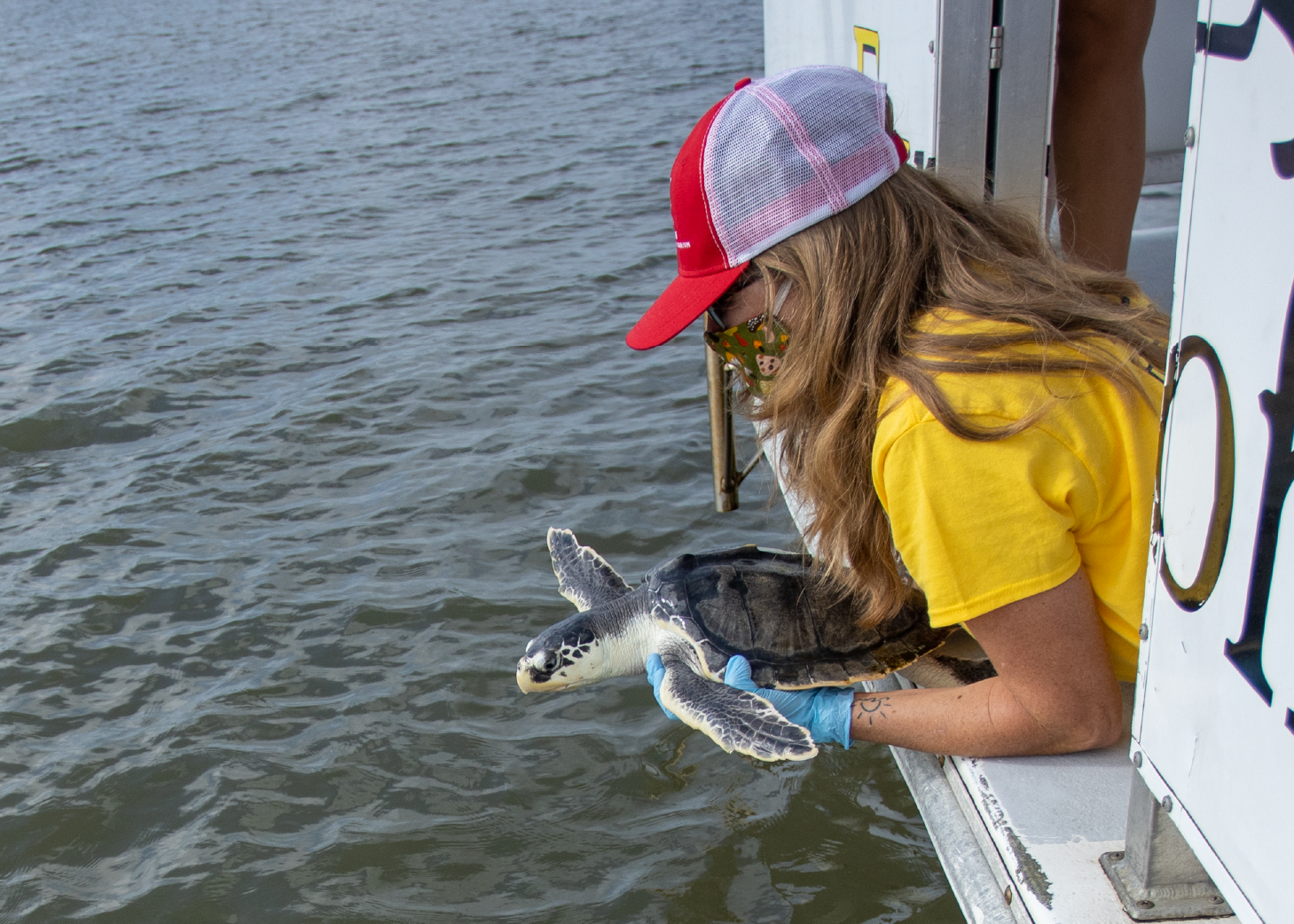 Jasper brought tears to our eyes as s/he raced through the water at this release.
Jasper brought tears to our eyes as s/he raced through the water at this release. Howlite Wears a Tailored Wetsuit (2021)
It’s not every day we encounter a unique medical case that pushes us to think outside of the box (ahem, tank!) in terms of palliative care, but Howlite’s story showcases the creativity of our dedicated staff. This loggerhead sea turtle had a buoyancy disorder caused by a boat strike wound to her/his carapace, hindering Howlite from naturally diving and being released back into the wild. During Howlite’s stay, a crafty and creative team of caretakers came up with a solution for Howlite’s buoyancy issues — a custom weighted jacket to help balance her/him while swimming! Using neoprene and dive weights, the jacket was fit specifically for Howlite’s body shape and size, including strategically placed pockets so weights could be added or removed to help balance this loggerhead’s buoyant back end. This feat of ingenuity provided a long-term care solution for Howlite, who now resides at the Dallas Children’s Aquarium at Fair Park in Dallas, Texas.
 We spent two years caring for and treating Howlite's injuries and buoyancy issues before s/he was transferred.
We spent two years caring for and treating Howlite's injuries and buoyancy issues before s/he was transferred. Jim Becomes the 400th Release (2024)
Jim, a small but mighty green sea turtle, was more than just a celebration for our rehabilitation efforts. Jim was named in memory of a beloved colleague we lost the year prior, who left 16 years of impact at the Aquarium and helped to sustain our critical life support systems. We honored his dedication to our mission through this release.
 Jim was one of 10 sea turtles who returned home at this milestone release.
Jim was one of 10 sea turtles who returned home at this milestone release. Chia’s Small Size Causes a Stir (2024)
Opposite our largest sea turtle (Yawkey, weighing in at nearly 500 pounds), Chia checked into rehabilitation at a mere 1.46 pounds! This incredibly teensy turtle was found entangled in marine debris a few miles offshore, which resulted in a partial amputation of her/his right front flipper. Chia proved that size is no match against sheer resilience, and was released far offshore six months later.
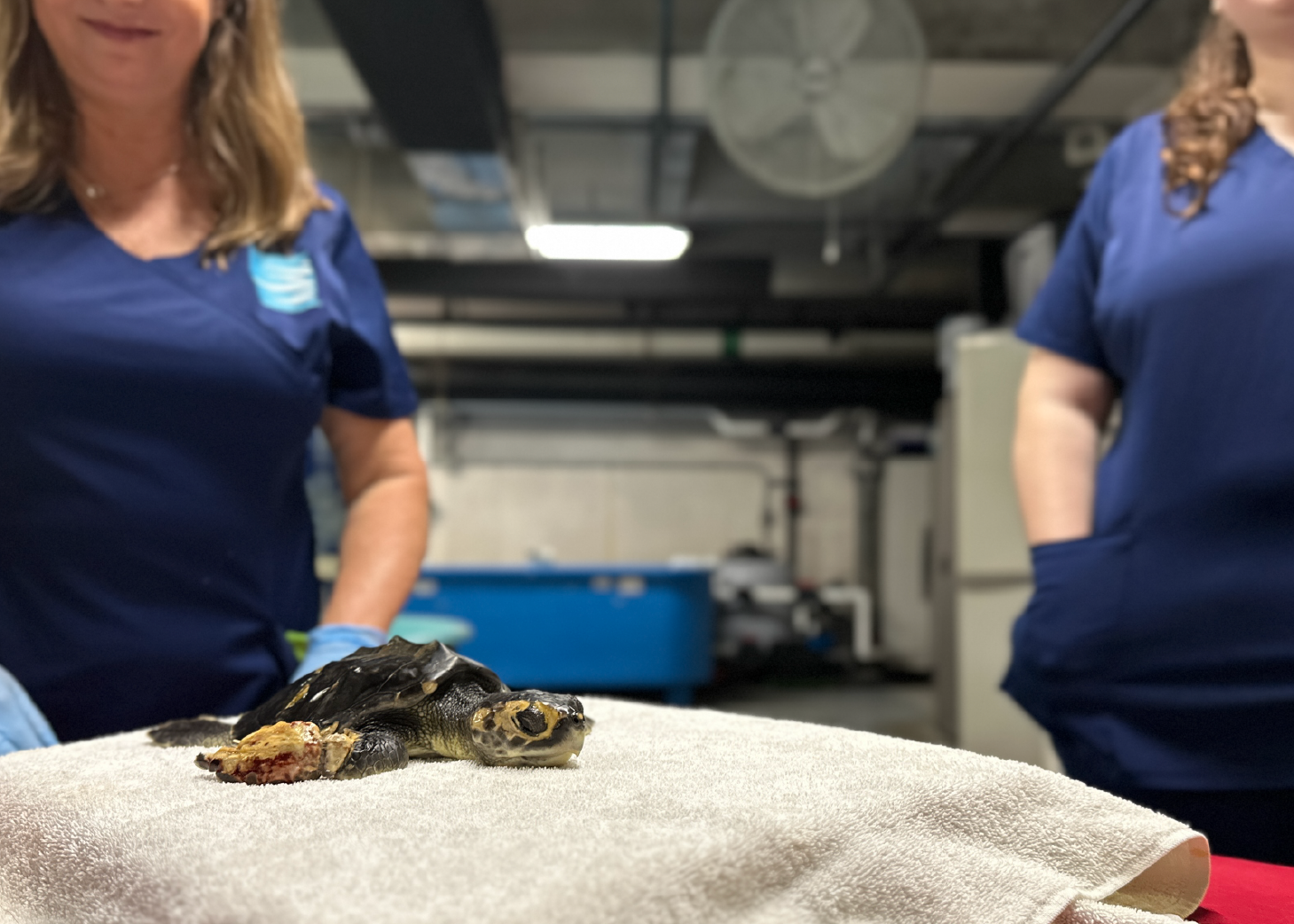 In addition to the partial flipper amputation, Chia's entanglement resulted in injuries to the skin on her/his face.
In addition to the partial flipper amputation, Chia's entanglement resulted in injuries to the skin on her/his face.It takes many hands to rescue, rehabilitate and release each and every sea turtle patient, and your support is integral in continuing our lifesaving operations. As we reflect upon this handful of memorable patient stories, imagine the impact we can make together for the future of this incredible endangered species.
Join us for the next 25 years of saving sea turtles!
Published May 15, 2025


